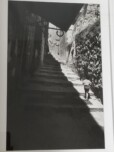I first met Bev Abramson when she was the coordinator for the Coop program in administration at the University of Toronto at Scarborough. But she is also a talented photographer and in the mid-Nineties she decided to leave UTSC to begin her second career.
I kept in touch with her and hired her to photograph my wedding. I went to Bev’s exhibits and watched her new career flourish. When our colleague Myer Brody decided to retire, I had the department buy one of Bev’s photographs for him. Myer had a fondness for cigars. Bev, it turns out, had been photographing in Cuba, and we chose her portrait of Alejandro Robaina, a legendary cigar producer, drawing a first puff. The photo delighted Myer. My colleagues must have remembered this because, when I completed my term as Chair, they gave me her 16 x 10 inch photograph entitled “On a Mission.”
A Child on a Mission
I think this is a brilliant photograph and I’ve hung it in our vestibule, with a spotlight illuminating it. I see it several times a day, and never tire of it. Bev thinks it is one of her best and it is on display in a prominent place in her home. She and I recently discussed it.
Bev was visiting Israel in 2002 and was walking in Jerusalem one morning. She came to an alley and was struck by the contrast between the warm bright light and the cold dark stones. She had the setting for a photo, now she needed something to happen. So she waited.
She snapped a child running up the steps “on a mission.” The child gives the photograph motion, energy, and mystery. Is the child a boy or girl? Israeli or Palestinian? Bev saw in the child’s motion determination and purpose, but what was the purpose? Where is the child going – school or some other place? Why is the child alone? Bev didn’t speak to the child, so many different stories can run through the viewer’s mind.
This is a photograph that embodies many contrasts: sunlight and shade, warmth and cold, the smoothness of the steps and the roughness of the stone wall, and the youth of the child and the agedness of the stone. (Bev reminded me that the stone is so old it has a unique smell.) I particularly like how the steps are partially in sun and partially in shade and how you can see the difference between the shade on the steps and the barely visible walls on the left.
The photo also makes wonderful use of shapes and perspective. The shaft of bright light on the steps leads to the photo’s vanishing point. It also crosses the horizontal lines of the steps. The buildings on the left create vertical lines that meet the horizontal steps and diversity is created by the triangular shape of the awning at the top, the near-circular metal figure attached to the awning, and the roughness of the stone on the right.
Just as Christians make pilgrimages to the Holy Land, Jews go on missions to Israel. Bev took this picture in 2002, on a personal mission to document Jewish life in Israel during the Second Intifada. The context in which she took the photo raises other possible (and conflicting) metaphors: light and darkness as unending conflict between Israelis and Palestinians, or the shaft of light pointing to hope in the future.
In an artist’s statement for an exhibit of her photos in Israel, she writes,
“How do [Israelis] deal with their fears and keep smiling, I keep asking myself. They have become believers – believers in life. Leaving their homes to go to shop, to school, to work, to the dentist, to a café, to the beach, to the ballet, to meet a friend, all that we take for granted, has become a test. A test of the will to live a normal life. But in reality this normalcy has become a matter akin to playing Russian Roulette. Every Israeli therefore has become a fatalist and expresses their philosophy of life by living. They don’t look for danger and don’t ask for trouble. Instead, they make weddings; celebrate birthdays and anniversaries; travel to spas; go on vacation; seek volunteer opportunities; visit the wounded in hospitals; and send their children, grandchildren, husbands, and grandfathers into the army because they believe that this horror will one day end. After all, they have experienced these nightmares before. They are optimistic that the calmness they once experienced will return.”
Focusing on Motion
I was glad to have reconnected with Bev and found out about her career. A touchstone of her work has been capturing the human body in motion. She has photographed many types of dance: samba and capoeira in Brazil, tango in Buenos Aires, flamenco in Spain, cabaret in Cuba, classical dance in Israel, and exotic dancing in Toronto. She has published two collections, both of which are listed on Amazon: Bawdy Language: Exotic Dance (2003) and Off We Go (2010). The latter is of and for young children, who are perpetually in motion. Her profile and some of her photos can be found on Saatchi Art. Bev’s career as a photographer has gone from strength to strength, and I’m proud to have been a supporter of hers from the outset.


Leave a Reply